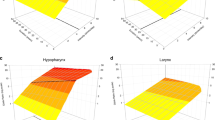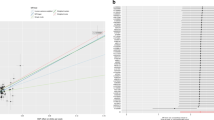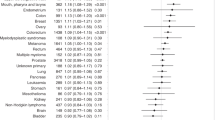Abstract
Data sources
Data are from the International Head and Neck Cancer Epidemiology (INHANCE) Consortium of case-control studies of head and neck cancer.
Study selection 15 case-control studies with detailed information on cigarette smoking and alcohol consumption were included.
Data extraction and synthesis
The authors pooled data from 15 case-control studies and modelled the excess odds ratio (EOR) to assess risk by total exposure (pack-years and drink-years) and its modification by exposure rate (cigarettes/day and drinks/day).
Results
The smoking analysis included 1761 laryngeal, 2453 pharyngeal and 1990 oral cavity cancers, and the alcohol analysis included 2551 laryngeal, 3693 pharyngeal and 3116 oval cavity cancers, with over 8000 controls. Above 15 cigarettes/day, the EOR/pack-year decreased with increasing cigarettes/day, suggesting that more cigarettes/day for a shorter duration was less deleterious than fewer cigarettes/day for a longer duration. Estimates of EOR/pack-year were homogeneous across sites, while the effects of cigarettes/day varied, indicating that the greater laryngeal cancer risk derived from differential cigarettes/day effects and not pack-years.
EOR/drink-year estimates increased through 10 drinks/day, suggesting that more drinks/day for a shorter duration was more deleterious than fewer drinks/day for a longer duration. Above 10 drinks/day, data were limited. EOR/drink-year estimates varied by site, while drinks/day effects were homogeneous, indicating that the greater pharyngeal/oral cavity cancer risk with alcohol consumption derived from the differential effects of drink-years and not drinks/day.
Conclusions
We observed an inverse exposure rate effect for cigarette smoking above 15 cigarettes/day, whereby the strength of the association between head and neck cancer and pack-years decreased with cigarettes/day, and a direct exposure rate effect for drinks/day ≤10 drinks/day, whereby the strength of the association between head and neck cancer and total drink-years increased with drinks/day.
Smoking risks were greater for the larynx than for the pharynx and oral cavity, while alcohol risks were greater for the pharynx and oral cavity. We found suggestive evidence that greater smoking-related risk of laryngeal cancer was derived primarily from the differential effects of cigarettes/day, while the effect of pack-years was similar by site, and that the greater alcohol-related risk for pharyngeal and oral cavity cancers was derived from a greater effect of total drink-years, while the modification of drink-years-related risk by drinks/day was similar for each site.
Similar content being viewed by others
Commentary
Oscar Wilde (amongst others) infamously said “everything in moderation, including moderation itself”. The response, in short, in relation to head and neck cancer risk from smoking and alcohol, is – “well, not quite!”.
Lubin et al. present the most comprehensive and in-depth analysis of the traditional risk factors for head and neck cancer – smoking and alcohol drinking. Uniquely, they investigate the differential risks for head and neck cancer (and for its subsites) associated with frequency (per day) and duration (per year) for these behaviours.
The methodology employed in this study is robust. This is the largest study of its kind, pooling data from 15 separate case-control studies from across Europe, North America, and South/Central America within the INHANCE (International Head And Neck Cancer Epidemiology) consortium.1 The smoking analysis contained around 2000 cases each of oral, pharyngeal and laryngeal cases; while the alcohol analysis had around 3000 cases of each. Comparisons were made with around 8000 controls.
The main findings reported were that fewer cigarettes smoked per day for many years gave a greater risk for head and neck cancer than many cigarettes smoked per day for fewer years. This was all the more interesting because the comparison between the two groups was for equal pack-years. (Where pack-years are defined as one pack of 20 cigarettes smoked each day for a year).
While for alcohol consumption, it was the other way round, heavy drinking per day for a few years gave a greater risk for head and neck cancer than fewer drinks per day for many years. This comparison was controlled for total alcohol exposure.
They also confirmed the relationship that smoking was more strongly associated with laryngeal cancers and alcohol consumption more strongly associated with pharyngeal and oral cavity cancers. However, this finding is reported in relative terms, the absolute risks are not clear from the data presented here, but one would expect the risk associated with oral and pharyngeal cancer to be greater from smoking than alcohol consumption – and this message may have got lost.
Furthermore, for both the smoking and alcohol analyses, there was no safe minimal limit at which either smoking or alcohol consumption was protective. Risk for head and neck cancer increased steadily through to 15 cigarettes per day; and through 10 alcoholic drinks per day.
Investigating the synergistic effect of magnifying the risks when both smoking and alcohol consumption, while beyond the scope of this analysis, could be interesting to throw into the mix in terms of the pattern analyses of these behaviours as examined here. And future analyses, assessing differences across the world and socioeconomic groups would also be interesting.
The findings cast further light on our understanding of the risk factors for head and neck cancer – it is not quite as simple an explanation as smoking and alcohol consumption per se. Both of these behaviours are highly complex. The findings also have subtle implications for policy and practice. While one would not wish these findings to be misrepresented as harm-reduction messages, better understanding these behaviours could potentially go some way towards developing behavioural risk assessment tools in the future.
And we all have to be careful with the old Scots saying “a little of what you fancy does you good”...
Declaration of interest: David Conway is a member of the INHANCE consortium, but was not involved in this study.
References
Conway DI, Hashibe M, Boffetta P ; INHANCE consortium, Wunsch-Filho V, Muscat J, La Vecchia C, Winn DM . Enhancing epidemiologic research on head and neck cancer: INHANCE - The international head and neck cancer epidemiology consortium. Oral Oncol 2009; 45: 743–746.
Author information
Authors and Affiliations
Additional information
Address for correspondence; Dr. Jay H. Lubin, Biostatistics Branch, Division of Cancer Epidemiology and Genetics, National Cancer Institute, 6120 Executive Boulevard, Rockville, MD 20852, USA. E-mail: lubinj@mail.nih.gov
Lubin JH, Purdue M, Kelsey K, Zhang ZF, Winn D, Wei Q, et al. Total exposure and exposure rate effects for alcohol and smoking and risk of head and neck cancer; a pooled analysis of case-control studies. Am J Epidemiol 2009;170: 937–947. Epub 2009 Sep 10.
Rights and permissions
About this article
Cite this article
Conway, D. “ Everything in moderation...? ”. Evid Based Dent 11, 89–90 (2010). https://doi.org/10.1038/sj.ebd.6400744
Published:
Issue Date:
DOI: https://doi.org/10.1038/sj.ebd.6400744



